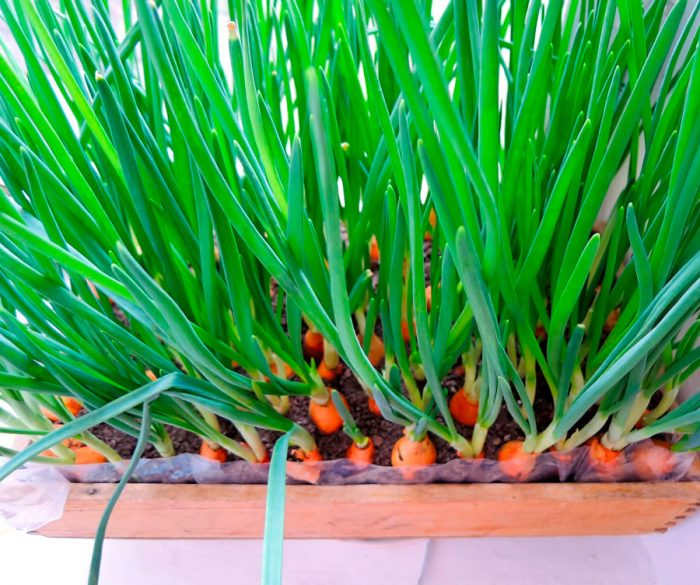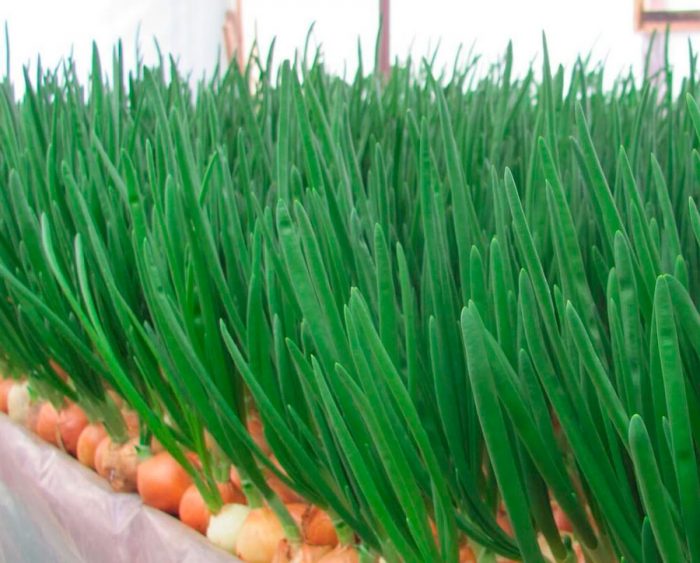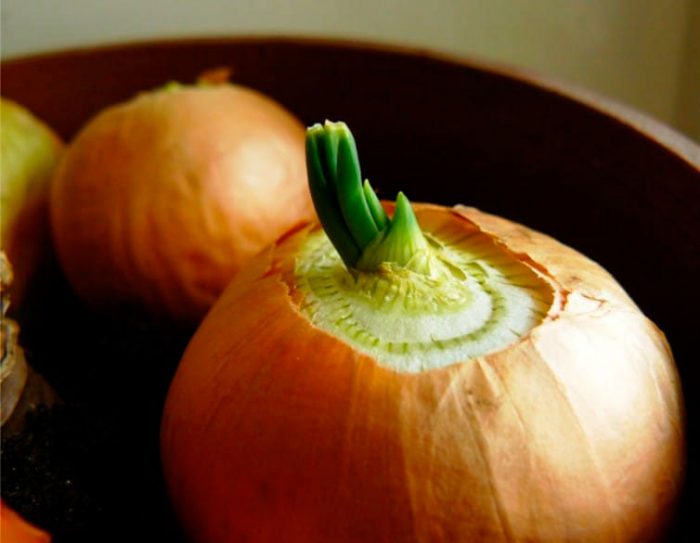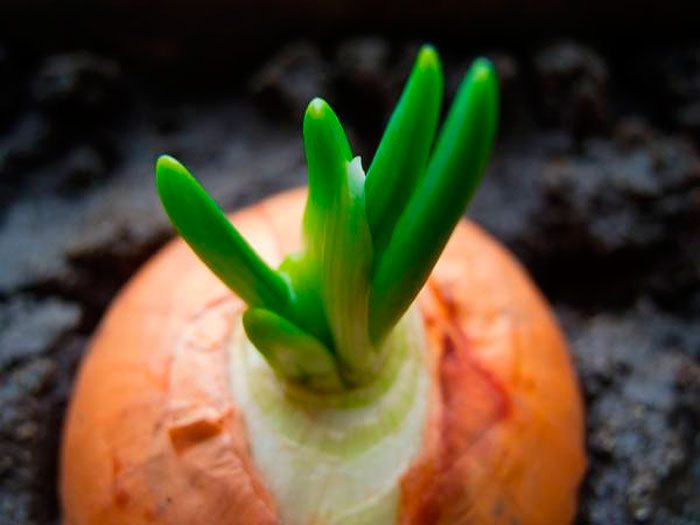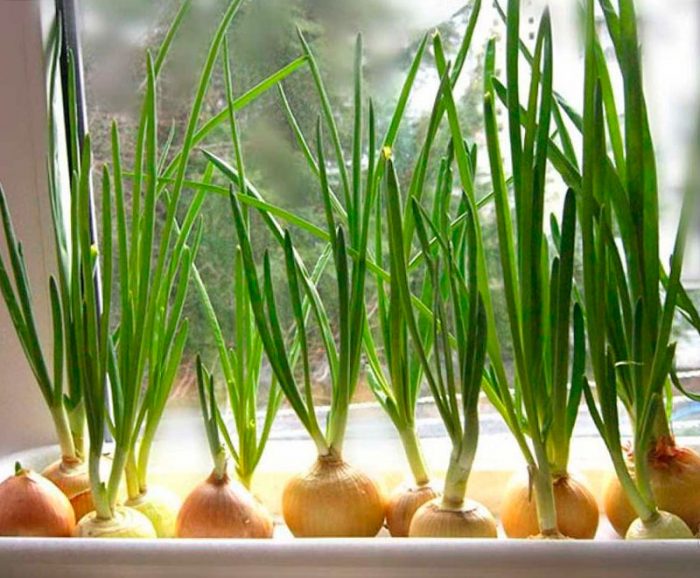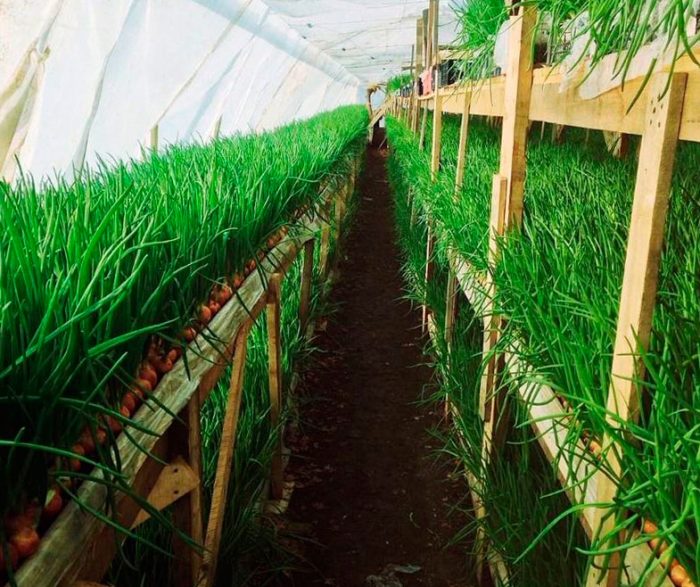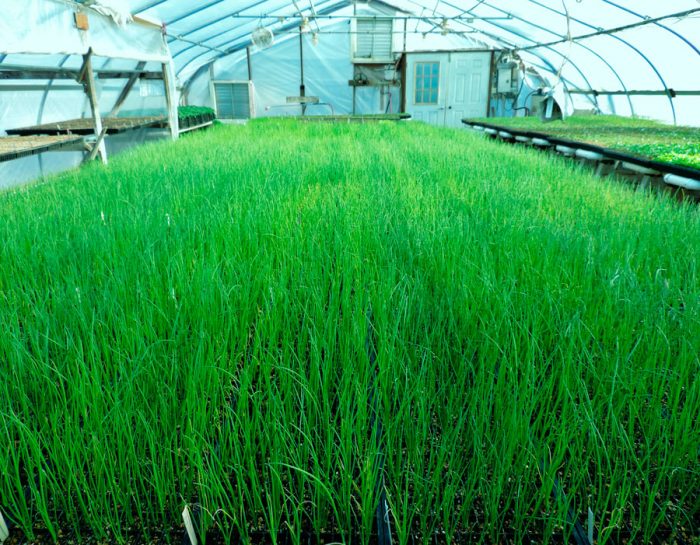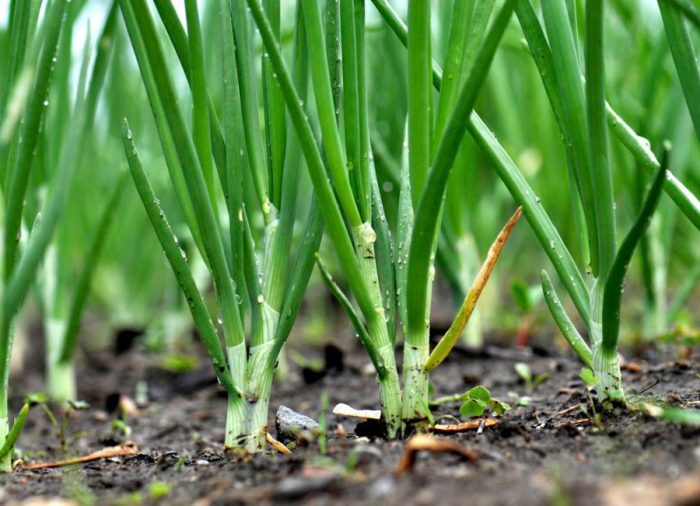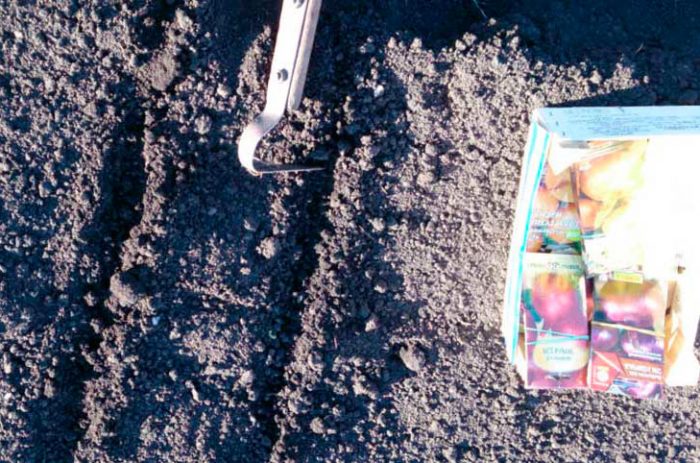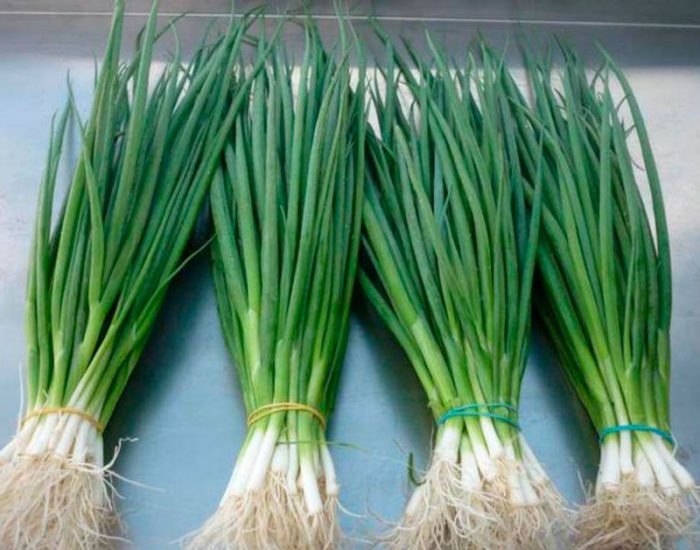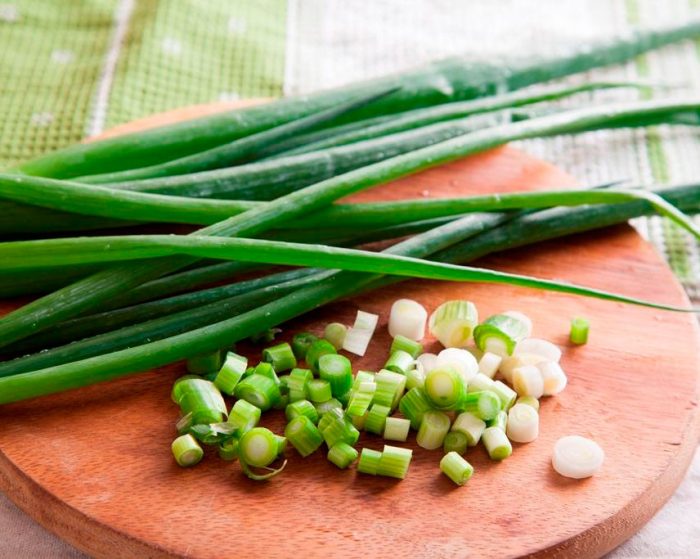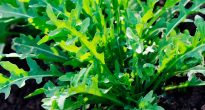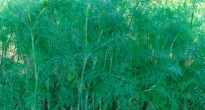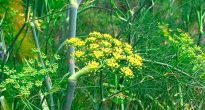Green onions not only can improve the appearance of any dish, but they also saturate it with vitamins necessary for the human body, especially in winter and spring. For example, vitamin C, which the human body needs so much during vitamin deficiency, is more in green onions than in onions. In order for tasty and healthy greens to be at hand throughout the year, you should definitely learn how to grow onions on a feather in a greenhouse or on a windowsill.
Content
Features of green onions
If you need to get a lot of green onions, then the best way to grow them is in a greenhouse. But in the event that you only need it for cooking various dishes, then you can drop it into a container and place it on your windowsill.
Man began to cultivate onions about 5 thousand years ago, so he is well aware of how to properly grow it not only in the garden, but also in indoor conditions. Green onions on a windowsill can be grown in water (hydroponically) or in a substrate. Both of these options are fairly straightforward, but there are still a few tricks that will help you get the best results possible.
Forcing onions on a feather (greens)
Preparing for landing
If you decide to grow onions on a feather, then the first step is to prepare the planting material. To do this, they are sorted, removing all the bulbs affected by the disease, deformed and injured. Examine each bulb, suitable for planting should be dense, with glossy scales and in no case should rot be present on them. Further, the top of each of the selected bulbs is cut off (1/4 of the entire bulb). Thanks to this, the air will quickly get to the kidneys and, as a result, the greens will appear as soon as possible. If sprouted bulbs are used for planting, then you do not need to trim them. Also, in order for feathers to appear faster, soak the material intended for planting in warm water (from 35 to 38 degrees), there it should stay for about 12 hours.
If you are planting onions in a soil mixture, then it also needs to be prepared.The substrate must be loose. And best of all, onions grow in humus, which is combined with vermiculite. Take a container and pour the potting mix into it in a layer of 7 to 10 centimeters, but do not forget to disinfect it before that. To do this, the substrate is spilled with a hot solution of potassium manganese, the color of which should be dark pink. After that, it is spilled with very cold clean water.
Landing rules
To obtain greens, the bulbs are planted in a container by the bridge method. To do this, they are placed almost closely, keeping a distance between them of 10–20 mm. Place the bulb on the bottom of the soil mixture and press it in a little. It is not necessary to bury or deeply deepen it, as this may cause rot. When the onions are planted, sprinkle the mixture with lukewarm water.
In order to grow onions on a feather in water, take a tray, put the bulbs in it close to it and fill it with water for ¼ part. After about half a month, greens will grow on the bulbs, which can be cut off and used in cooking. Monitor the water level in the sump and top up if necessary.
What time to plant
The average speed of forcing chives is 15–20 days. In a greenhouse and indoors, onions are planted on greens from October to April, in spring and summer they are grown in open soil. If you follow certain rules, then the greens on your table will be constantly.


Watch this video on YouTube
Growing onions on a feather at home
The container with the onions planted in it must be placed in a warm (from 25 to 30 degrees) for 7 days. After the length of the grown leaf plates is 10–20 mm, the planting is transferred to an unheated veranda or balcony. The growth rate of the feather from this point on will depend on the temperature of the water used for irrigation and the air.
How to care
Onions grow best at water temperatures of 20 to 25 degrees and air temperatures of 18–22 degrees. Watering is carried out 1-2 times in 7 days. When grown on a feather, you do not need to feed onions, because the greens take nutrients from the bulb. After the leaves reach a height of 25–35 centimeters, you can start harvesting. Cutting greens is carried out gradually, starting from the edges, since the growth of foliage is observed from the central part of the bulb. If you plant the bulbs systematically 1 time in 15-20 days, then fresh herbs on your table will be constantly.


Watch this video on YouTube
Growing onions on a feather in a greenhouse
Onions are driven out for feathers in greenhouse conditions in October – April; for this purpose, a sampled onion is used, which can be an annual or a biennial. Do not forget to prepare planting material before disembarking (see above for more details).
Its planting is carried out by the bridge method in boxes, into which humus, peat or compost are poured. The bulbs are covered with a thin layer of peat on top, and so that mold does not form on it, they are powdered with fluff lime. When the planting is complete, the boxes are placed one on top of the other and put away in a corner.
Basic rules of care
Until the greenery appears, the plantings are provided with the following temperature regime: at night - from 12 to 15 degrees, and during the day - from 18 to 20 degrees. Watering is carried out only when necessary, while the greenhouse must be systematically ventilated. When 10 to 12 days have passed, the length of the foliage will be 50-80 mm, and roots will grow at the bulbs. It should be noted that the color of the leaves will be white. At this stage, the boxes are placed on racks, and the air temperature is increased to 20-22 degrees, watering from this moment is carried out systematically.
In order for the feather to grow and develop within normal limits, the daylight hours should be 12 hours. Note that the lamps used for supplementary lighting must be placed vertically, only in this case the foliage will not break. The color of the foliage changes over time from white to green.
When two days have passed, after the boxes are placed on the racks, the onions are fed. For this, the surface of the soil mixture is sprinkled with dry nitrogen (from 20 to 40 grams of ammonium nitrate per 1 square meter) and potassium (from 10 to 15 grams of potassium chloride per 1 square meter) fertilizer. During watering, fertilizers will fall into the substrate itself. Cutting foliage can be carried out after its length is equal to 35 centimeters.


Watch this video on YouTube
Growing onions for greens in the open field
Winter planting onions on a feather
Green onions can also be grown in open soil. In this case, bulbs are chosen for planting, which reach 25–40 mm in diameter. Landing in the soil is carried out in late autumn, when about half a month will remain until severe frosts. Before this, the planting material is prepared, for this, it is processed with warm water and the tops are cut off.
You can plant bulbs in the ground using the bridge method. To do this, they are placed almost close to each other with the bottom down. Sprinkle them on top with a thin layer of soil (20 to 30 mm). You can also use the tape method for planting. In this case, the bulbs are planted in furrows, while the distance between them should be 10–40 mm, after which they are covered with soil. The row spacing in this case should be 10–20 centimeters.
Autumn care rules
In order to prevent the bulbs from freezing in the winter months, in the fall, the planting from above must be covered with a layer of manure or humus, the thickness of which must be at least 35-50 mm. With the onset of spring, this layer is carefully removed, and a film frame is installed over the plantings. Before severe frosts begin, the beds are regularly watered so that the soil is slightly moist all the time. This is necessary so that the root system grows in the bulbs.
Onions on greens from seeds
If desired, green onions can be grown from seeds that are much cheaper than selected onions, but this method will not allow you to get greens quickly. Sowing seeds of perennial onions on greens is carried out in the summer, or rather in mid-July. The site must be dug up in advance, while all the necessary fertilizers are introduced into the soil. Make rows, spread the seeds evenly and cover them with soil. The row spacing should be 0.3–0.4 m. After the seedlings have the first leaf plate, they are thinned out. The distance between them should be 35-50 mm. In late autumn, the surface of the bed should be covered with straw or covered with a layer of peat. In the spring, immediately after the snow melts, fresh greens will grow in the garden.
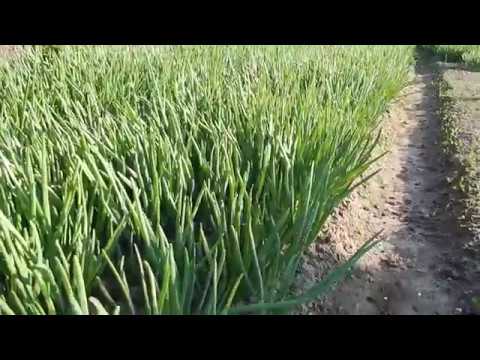

Watch this video on YouTube
Onion varieties per feather (greens)
What types of onions are grown on a feather
Summer residents most often grow the following types of onions on a feather:
- Onion (onion-fist, or Tatar, or winter, or sandy). It gives even greenery. In varieties of annuals, cutting of greens during the growing season is carried out only once, and in perennials - 2 or 3 times.
- Tiered bow (Canadian or Egyptian). This species is one of the most unpretentious and winter-hardy. In terms of yield and quality of feathers, it surpasses the onion.
- Chives (chisel). The species has a fairly high yield. The height of fragrant leaves is about half a meter, they remain tender for a long time.
- Slime onion... This early maturing species is characterized by frost resistance and productivity. Wide flat leaf plates have a delicate texture and a mild garlic odor.
- Leek (pearl). The type is fruitful. Its succulent wide leaf plates are very similar to garlic foliage.
- Shallot... This productive species, distinguished by its unpretentiousness, has foliage that does not fade for a long time.
The best varieties of onions for herbs
On a feather, multi-primordial onion varieties are grown, which form a large amount of foliage, and even single-primordial ones - they grow very little greenery. The best multi-primordial varieties are: Bessonovsky, Rostovsky, Spassky, Arzamassky, Strigunovsky, Danilovsky, Ryazansky, etc.
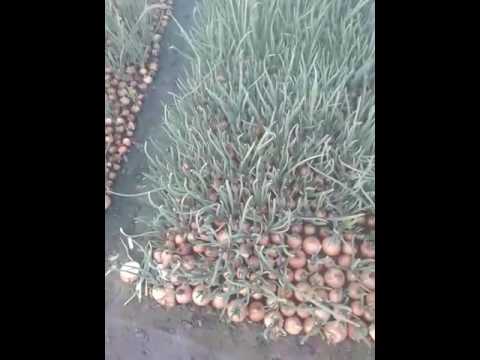

Watch this video on YouTube
Properties of green onions: harm and benefit
The healing properties of onions
It has already been said above that onions contain a large amount of macro- and microelements, as well as vitamins, therefore it is very useful for vitamin deficiency, which is most often observed in winter and early spring. Also, experts advise to include it in their diet for people suffering from respiratory diseases as a general tonic. It contains a lot of phytoncides that actively fight against pathogenic bacteria and viruses, effectively cleansing the human body from them, and also the room where the onion itself is grown.
The composition of such greens includes chlorophyll, which, together with other useful substances contained in feathers, participates in the process of hematopoiesis. In this regard, it is recommended to regularly eat this greens for people suffering from anemia. Onion leaves also contain essential oils that are able to cope with viruses and infections of dysentery, diphtheria, tuberculosis and tonsillitis. These oils disinfect the oral cavity and also help to normalize the heart.
Even the feathers of such a vegetable contain zinc, nitrogen, calcium, potassium, phosphorus and magnesium, if they are not enough for the human body, hair loss will begin, and the nails will become fragile and exfoliate. In addition, the following vitamins are present in greens:
- A (beta-carotene)... This powerful antioxidant helps to improve vision and skin condition as well as strengthen hair and nails. It normalizes the heart and protects the body from the harmful effects of free radicals.
- B1 (thiamine)... This vitamin is involved in the regulation of fat, protein and carbohydrate metabolism.
- B2 (riboflavin)... Helps to neutralize toxins that irritate the respiratory tract, as well as maintain reproductive function. He also takes part in the formation of red blood cells.
- B3 (vitamin PP, or nicotinic acid, or niacin)... Removes excess cholesterol from the body, strengthens the immune system and participates in the breakdown of fats, proteins and carbohydrates.
- B9 (folic acid)... Takes part in the synthesis of proteins and regulates the work of the nervous system.
- C (ascorbic acid)... This biologically active substance is a powerful antioxidant. It takes part in the production of hormones and helps the body fight off viruses and bacteria.
- E (tocopherol)... Normalizes the work of the male and female reproductive organs. Promotes rejuvenation of the body, gives elasticity to hair, nails and skin.


Watch this video on YouTube
Contraindications
Experts do not advise including fresh onion leaves in your diet for ulcerative diseases of the digestive system and for gastritis with high acidity. It is better for hypertensive patients to refrain from eating large amounts of green onions, as it increases blood pressure. With diseases of the cardiovascular system, as well as with bronchial asthma, you should be careful in using green onions, and during an exacerbation of diseases it is better to refuse it altogether.

